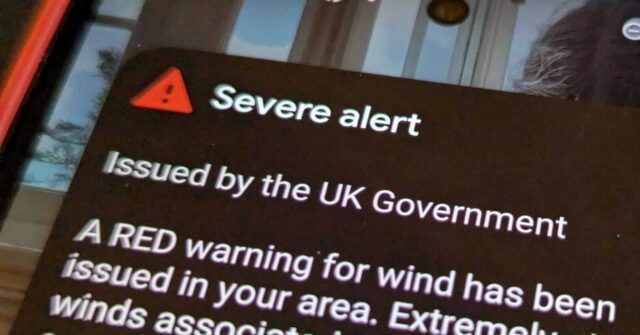The UK government recently activated its emergency alert system to send out red warnings to mobile phone owners across affected regions. This emergency alert, which reached approximately three million residents in Wales and South West England, was triggered by a severe weather forecast predicting wind gusts of up to 90 miles per hour. These dangerous conditions are expected to lead to potential hazards including flying debris, falling trees, and large coastal waves. Given the severity of the storm, which was set to impact the area overnight into Saturday, the Meteorological Office advised the public to prepare for consequences such as power outages, disruptions in telecom services, and road and rail closures, while also anticipating significant damage to structures including roofs and power lines.
To ensure public safety during the impending storm, relevant authorities advised residents to secure loose items in their outdoor spaces and to ensure that doors are tightly shut. The guidance emphasized the importance of staying indoors as much as possible, recommending that individuals avoid situations that could put them near large structures or trees. As a precautionary measure, those living in homes with aging chimneys were advised to relocate sleeping arrangements away from areas directly beneath these structures. The proactive measures taken by emergency services were designed to both inform and protect the public as the storm approached.
The emergency alert system’s notification was unprecedented in scale, marking its largest deployment to date. The system, which functions by notifying all mobile phones connected to specific networks in an affected area, ensured that even devices on silent would emit a loud klaxon to capture attention. Besides the klaxon, compatible handsets also featured text-to-speech technology that audibly read out the message after the sound alert, thereby ensuring that the information was accessible to those who might not have been able to read the message themselves. This activation was part of a broader effort to modernize the country’s emergency response capabilities in light of recent severe weather incidents.
Historically, emergency warning systems in the UK have been sporadic in their use, with only a handful of real emergencies triggering alerts since the technology was first tested in 2021. The government’s records reveal that there have been four tests of the alert system across the country; however, it has been formally utilized only in two emergencies prior to this latest storm warning. These two instances included an alert regarding a discovered unexploded bomb from World War II and another for flood risks in Cumbria. This limited deployment underscores the system’s relative novelty in the landscape of the UK’s emergency preparedness strategies.
The UK once enjoyed a more comprehensive physical emergency warning system designed to alert citizens to various threats, particularly during wartime. Originating from World War II, sirens were placed in cities and towns to warn of impending bombings. This infrastructure was further developed during the Cold War to prepare for potential nuclear attacks. However, over the years, most of this system has deteriorated, and only sporadic emergency warning sirens remain active, primarily near military installations or flood-prone areas. The reduction of these physical warning systems signifies a shift in reliance towards modern digital alert systems amid changing hazard landscapes.
Reflecting on the importance of effective emergency warning mechanisms, one of the starkest reminders of the past is the North Sea flood disaster of 1953, which illustrated significant failures in alerting the public. This catastrophic event led to the deaths of over 300 people, largely due to the inability to communicate effectively as the storm damaged essential telephone and power lines. The tragedy primarily affected vulnerable populations, particularly the elderly, who were unaware of the rising waters during the night. This historical incident emphasizes the necessity for robust emergency communication strategies, as the recent activation of the alert system sought to ensure that modern technology does not allow for a repeat of past failures where timely warnings could have mitigated loss of life.

